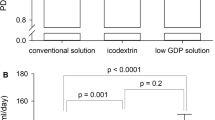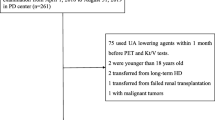Abstract
Background
Peritoneal protein clearance (Pcl) is related to the mortality of patients on continuous ambulatory peritoneal dialysis (CAPD) as well as technique failure. In this prospective observational study, we aimed to investigate factors associated with the level of Pcl.
Methods
We prospectively enrolled 344 prevalent CAPD patients. A standard peritoneal equilibrium test was conducted for each patient. Baseline demographics, biochemistry, and Pcl were recorded.
Results
The average Pcl of the patients was 97.40 ± 54.14 mL/day. Peritoneal transport level, serum high-sensitivity C-reactive protein (hsCRP), and residual glomerular filtration rate (rGFR) were independently related to Pcl. The standard β values were 0.53, 0.17, and −0.10, respectively. Moreover, compared with non-diabetic patients, diabetic patients had a non-significantly higher level of Pcl (104.90 ± 48.65 vs. 96.15 ± 54.97 mL/day; P = 0.06).
Conclusion
Continuous ambulatory peritoneal dialysis patients lose a high amount of protein through the peritoneum each day. The Pcl value is positively related to the level of peritoneal transport and hsCRP and negatively related to the rGFR.

Similar content being viewed by others
References
Avram MM, Fein PF, Bonomini L et al (1996) Predictors of survival in continuous ambulatory peritoneal dialysis patients: a five-year prospective study. Perit Dial Int 16(Suppl 1):S190–S194
Yeun JY, Kaysen GA (1997) Acute phase proteins and peritoneal dialysate albumin loss are the main determinants of serum albumin in peritoneal dialysis patients. Am J Kidney Dis 30:923–927
Brimble KS, Walker M, Margetts PJ et al (2006) Meta-analysis: peritoneal membrane transport, mortality, and technique failure in peritoneal dialysis. J Am Soc Nephrol 17:2591–2598
Dong J, Chen Y, Luo S et al (2013) Peritoneal protein leakage, systemic inflammation, and peritonitis risk in patients on peritoneal dialysis. Perit Dial Int 33:273–279
Perl J, Huckvale K, Chellar M et al (2009) Peritoneal protein clearance and not peritoneal membrane transport status predicts survival in a contemporary cohort of peritoneal dialysis patients. Clin J Am Soc Nephrol 4:1201–1206
S´anchez-Villanueva R, Bajo A, del Peso G et al (2009) Higher daily peritoneal protein clearance when initiating peritoneal dialysis is independently associated with peripheral arterial disease (PAD): a possible new marker of systemic endothelial dysfunction? Nephrol Dial Transplant 24:1009–1014
Rippe B (1993) A three-pore model of peritoneal transport. Perit Dial Int 13(2):35–38
Twardowski ZJ, Nolph K, Khanna R et al (1987) Peritoneal equilibration test. Perit Dial Bull 7:138–147
van Olden RW, Krediet RT, Struijk DG et al (1996) Measurement of residual renal function in patients treated with continuous ambulatory peritoneal dialysis. J Am Soc Nephrol 7:745–750
Wang T, Heimbürger O, Waniewski J et al (1998) Increased peritoneal permeability is associated with decreased fluid and small-solute removal and higher mortality in CAPD patients. Nephrol Dial Transplant 13:1242–1249
Sezer S, Elsurer R, Afsar B et al (2007) Peritoneal small solute transport rate is related to the malnutrition inflammation score in peritoneal dialysis patients. Nephron Clin Pract 107:c156–c162
Balafa O, Halbesma N, Struijk DG et al (2011) Peritoneal albumin and protein losses do not predict outcome in peritoneal dialysis patients. Clin J Am Soc Nephrol 6:561–566
Lindholm B, Werynski A, Bergstrom J (1987) Kinetics of peritoneal dialysis with glycerol and glucose as osmotic agents. ASAIO Trans 33:17–29
Szeto CC, Chow KM, Lam CW et al (2005) Peritoneal albumin excretion is a strong predictor of cardiovascular events in peritoneal dialysis patients: a prospective cohort study. Perit Dial Int 25:445–452
Noh H, Lee SW, Kang SW et al (1998) Serum C-reactive protein: a predictor of mortality in continuous ambulatory peritoneal dialysis patients. Perit Dial Int 18:387–394
Kaysen GA, Schoenfeld PY (1984) Albumin homeostasis in patients undergoing continuous ambulatory peritoneal dialysis. Kidney Int 25(1):107–114
Heaf J (2003) High transport and malnutritioninflammation-atherosclerosis (MIA) syndrome. Perit Dial Int 23:109–110
Tinroongroj N, Jittikanont S, Lumlertgul D (2011) Relationship between malnutrition-inflammation syndrome and ultrafiltration volume in continuous ambulatory peritoneal dialysis patients. J Med Assoc Thai 94(4):94–100
Coronel F, Cigarrán S, Herrero JA (2009) Peritoneal protein losses in diabetic patients starting peritoneal dialysis: is there a relationship with diabetic vascular lesions? Adv Perit Dial 25:115–118
Conflict of interest
The authors have no financial conflicts of interest to declare.
Author information
Authors and Affiliations
Corresponding author
Rights and permissions
About this article
Cite this article
Tang, Y., Zhong, H., Diao, Y. et al. Peritoneal transport rate, systemic inflammation, and residual renal function determine peritoneal protein clearance in continuous ambulatory peritoneal dialysis patients. Int Urol Nephrol 46, 2215–2219 (2014). https://doi.org/10.1007/s11255-014-0744-8
Received:
Accepted:
Published:
Issue Date:
DOI: https://doi.org/10.1007/s11255-014-0744-8




